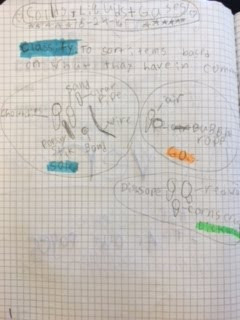I like to think of these next several things as foundational experiences - they are kind of a big deal if you want things to keep progressing with your students' notebooks. Decisions will need to be made, either by you, by a collective staff, or with your students. Decisions like - what are our expectations for our grade level? Are there any tools (table of contents, index, glossary, etc.) that we are all going to agree to use? How much "freedom" do they have in terms of set-up or layout? Will the notebook be used only for this grade level, or will we pass them on to the next grade level?
I admit that at the beginning I wanted a LOT of control (WHAT? Who me???) over what the kids' notebooks looked like, but I've come a long way in turning over the reins to them. You have to start with a level that is comfortable for you, so if that's giving them papers to tape in and letting them fill in what they need to - do it. If you're okay with letting it be completely free choice how they set it up - that's okay too. I'm about 3/4 of the way on the spectrum to free choice, but I do have some things I require to try to aid them in the process of using this as a tool (keep reading to find out what!).
This approach is similar to "The First 20 Days" of Readers/Writers Workshop in that you're getting all the fundamentals out of the way. These are short mini-lessons (5-10 mins) - no need to over-teach since they'll be using these ideas right away, and for many days throughout the year. Create an anchor chart, or not - whatever works for you! While there isn't necessarily a right order for this - you want them to be "just-in-time" lessons. For example, you don't have to teach them how to tape a paper into their notebook until they have a paper to add into their notebook (yes, seriously, you need to teach them how to use tape...otherwise it's like they're trying to put a frame around the Mona Lisa...).
So here's how it works for me, but naturally you'll need to tweak it to fit your needs!
Foundational Experiences:
During Notebooking Immersion Day:
*What is a Science Notebook?
*Respecting Others’ Notebooks and Ideas
*Notebook Walks
*Technical Drawings (Drawing Scientifically)
*Always/Never Expectations
First Science Class Period:
*Getting Notebooks (Who? From where? When?)
*Storing Notebooks
*Caring for Science Notebooks
*Sections of a Science Notebook
*Table
of Contents (optional for my kids)
*Numbered
Pages
*Index
*Further Investigations/Questions (optional for my kids)
*Adding in pre-made sheets (tape/glue)
In the First Several Days:
*QCE Format (Question, Claim, Evidence)
*Using highlighters
*T-charts
*Using notebook space efficiently (if needed)
*Using color
*Using bold, large, colored font to make things stand out
*Top-view vs. Side-view
It's so fun to see how they use their notebooks to organize the information inside their head. Here are a couple of snapshots from our first science activity. Students were classifying matter as either solid, liquid, or gas. Required pieces - date, heading, important word (classify), and showing their information some how. Check out how different brains have used their notebooks to show their thinking!
I feel like we're up and running! I know they have many, many mini-lessons to come (I embed them with our science curriculum), but I'm pretty pleased with their first attempts! It is slow-going for sure at the beginning, but they'll get faster and better as we move forward!
I'll include more mini-lesson ideas later on down the line so we can look at how ELA and math objectives can be supported through use of notebooks as well. :) If I've left anything out, or you have a question feel free to ask! :)
Next blog topic??? How to manage all that science stuff!







No comments:
Post a Comment